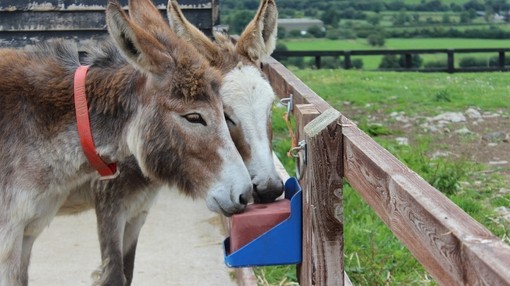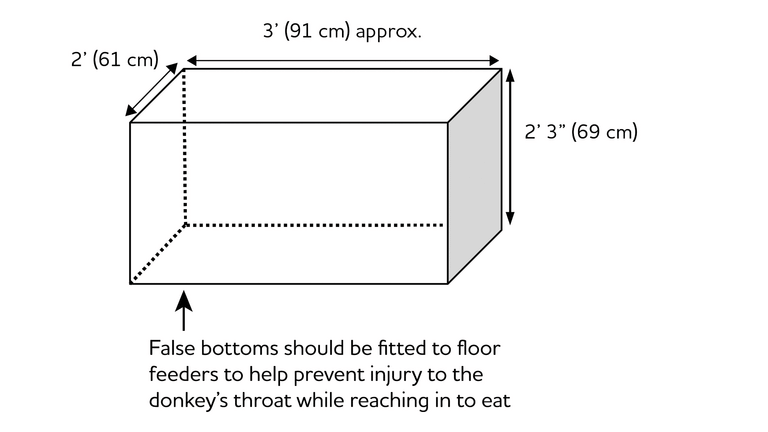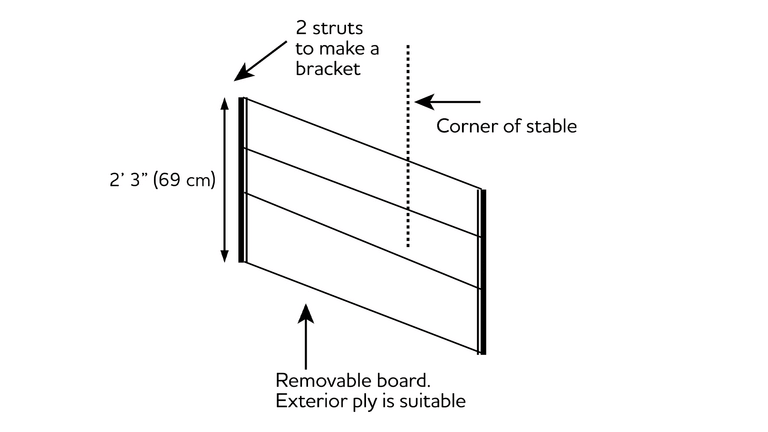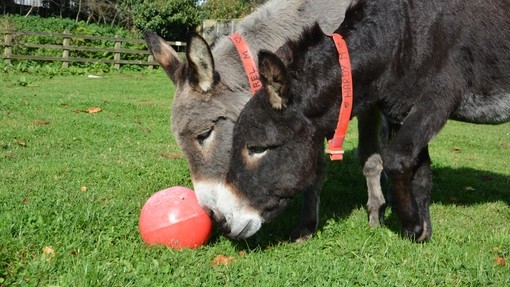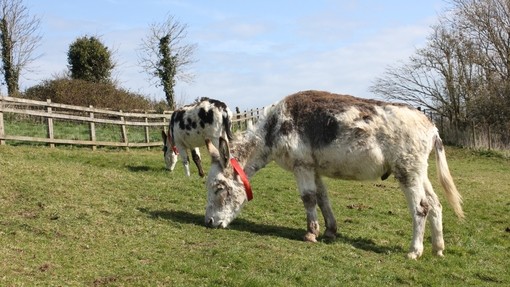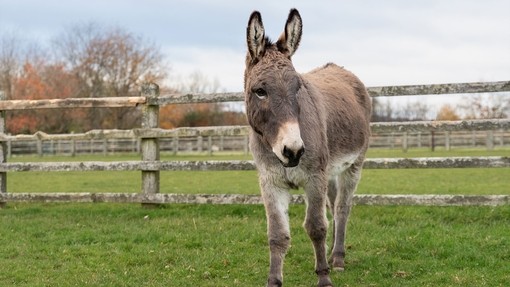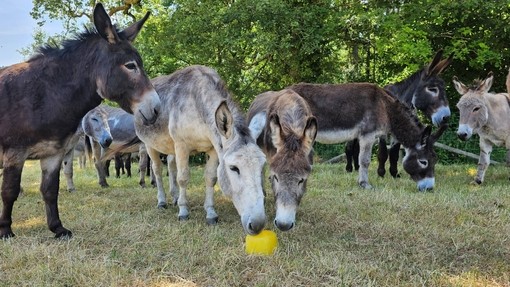What is the ideal stable or shelter size?
For a standard/average sized donkey allow approximately 4.7 square meters (50 square feet) of covered area per donkey for their bedded area. That is approximately 9.4 square meters (100 square foot) for a pair.
Make sure there is sufficient headroom for both animals and humans. Your donkey should be able to rear without hitting their head.
Consider that your donkeys need indoor space that provides enough bedded space to rest, but should ideally have more room to move around indoors if unable to go outside.
What height should the stable doors be?
The stable door should be low enough for your donkey to lean over to see out, but high enough to prevent them jumping out.
Stable doors made for horses at 4’ 6” (132cm) are too high for standard donkeys, but may be suitable if you have a large donkey breed.
Doorways should be a minimum of 3’11” (1.2 m) wide for an individual or pair of donkeys. Larger groups will need bigger doorways, or more open doorways to exit through.
It is advisable to have a bottom bolt as some donkeys can learn to undo the top one. A bottom bolt will also prevent the donkey from getting their foot caught in the door should he kick it. Kick bolts are the easiest to use as they can be operated with your foot.
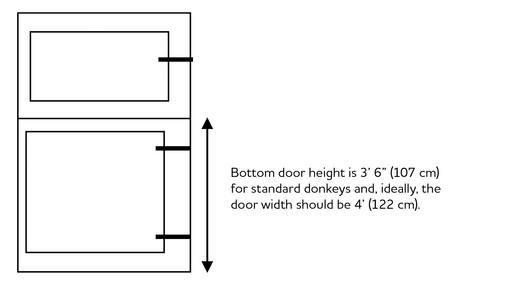
What sort of feeder should I provide?
Provide a floor-level feeder that has no sharp edges, so your donkey can eat from the ground as they would naturally. The top edge of the feeder must be low enough to make sure the donkeys can reach the floor without obstructing their windpipe. Avoid using haynets and hayracks. These encourage your donkey to reach up to eat, which can dislodge particles of hay or straw into your donkey’s ears and eyes. Breathing dust from a feeder can make respiratory problems worse. In addition, the safe height for tying a haynet is likely to differ between individuals in a mixed-size group, which could pose a risk of injury.
Make sure there is enough space for all donkeys in a group to feed at the same time. Donkeys need a minimum head space width of 2’5” (0.75 m) each for feeding from a trough.
Where possible, position the feeder so your donkey is not standing on their bedding while eating. This prevents their feet becoming saturated by damp bedding, particularly during the winter months.
Place enough straw in the feeder to allow your donkey to browse through it. If your donkey does not eat all the straw provided, use it as bedding the following day.
If the feeder is deep, fit a false bottom. This will reduce how far your donkey must stretch to reach the forage, helping to prevent injury.
Fill your donkey’s feeder to the height of their shoulder; any higher and straw could get in their ears or eyes.
Avoid using haynets and hayracks. These encourage your donkey to reach up to eat, which can dislodge particles of hay or straw into your donkey’s ears and eyes. Breathing dust from a feeder can make respiratory problems worse. In addition, the safe height for tying a haynet is likely to differ between individuals in a mixed-size group, which could pose a risk of injury.
What sort of water supply should I provide?
Donkeys must always have access to a clean, fresh water supply.
Donkeys are very fussy about what they drink, most donkeys do not like drinking very cold water. Add some warmer water to your donkey’s bucket in cold weather.
A securely supported bucket or a self-filling trough should be constantly available to your donkey. This should be the case at all times, both when in their stable and out at grazing. It is important to clean our your donkey’s water supply daily, as they are likely to refuse contaminated or dirty water.
Position buckets in an accessible place, not in a corner or next to other resources and it is a good idea to provide more than one bucket to reduce any problems with resource guarding.
Using buckets allows you to monitor how much water your donkey drinks. Knowing if your donkey has been drinking more or less than usual is useful, particularly if you need to speak to your vet because your donkey is unwell. However a self-filling water trough does mean that the donkeys’ water will not run out during the day or night. Check the trough regularly to make sure it is working. If your donkey is unused to this type of trough, the noise when it is filling may startle them. Provide a bucket as an alternative while your donkey gets used to the noise, or if they will not drink from the trough.
As a rough guide, the trough should measure approximately 1’8”-2’ (50-60 cm) from its top edge to the floor. It will need to be lower if your donkey is a miniature donkey.
Donkeys cannot drink frozen water. Help prevent troughs freezing over by:
- Placing a small floating football in the trough to keep the surface water moving
- Covering and insulating part of the trough with plywood, leaving a smaller space for your donkey To drink from. Make sure there are no sharp edges.
- Placing it where it will catch the winter sun during the day, if the trough is mobile
- Placing a bucket of water in your donkey’s stable where it is less likely to freeze.
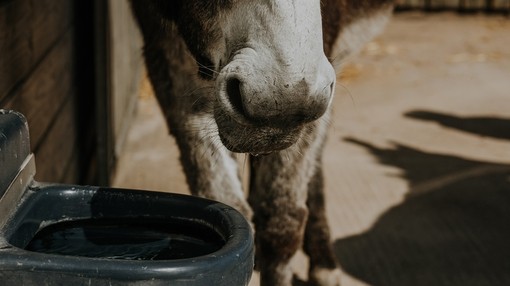
Do I need an electricity supply to my donkey's stable?
An electricity supply to your donkey’s stable is extremely useful. You can use it for:
- Electric lighting, particularly during the winter months
- Boiling a kettle as a source of warm water
- Powering clippers
- Certain procedures your vet may need to carry out
- Powering heat lamps to provide a source of warmth. This is especially important for elderly or unwell donkeys.
For safety you should:
- Encase all wiring in rodent-proof tubing
- Make sure all switches are weatherproof, donkey-proof and positioned outside the stable
- Protect lights with plastic covers and wire mesh guards.
What else should I consider?
Tie rings
- Fit tie rings at the level of your donkey’s eye.
- Do not tie your donkey directly to the metal ring. Instead tie to bailing twine attached to the ring. Bailing twine needs to be split so it will break in an emergency if your donkey panics, reducing the risk of injury. Never leave your donkey tied up unattended.
Mineral lick
Mineral licks provide enrichment and can supplement your donkey’s diet. If you feed your donkey a vitamin and mineral balancer, there is no need to supplement with a mineral lick. If you are unsure, ask your vet.
Avoid molassed treat licks. They are high in sugar, which increases your donkey’s risk of developing laminitis. Separation between the location of the mineral lick and the water supply will decrease competition for access to each.
